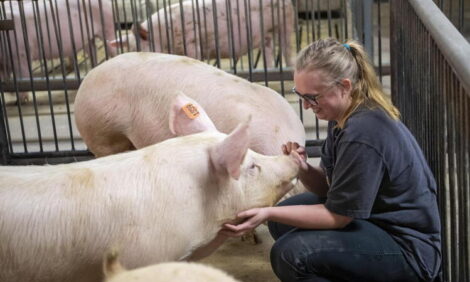



Lysozyme Improves Growth and Small Intestinal Morphology in Nursery Pigs
New research from the USDA shows that lysozyme has potential as an alternative to antibiotics in the diet of weaned pigs.Lysozyme is a 1,4-β-N-acetylmuramidase that has antimicrobial properties, according to William Oliver and J. E. Wells of the USDA, ARS, US Meat Animal Research Center in Clay Center, Nebraska.
The objective of their experiment, published in Journal of Animal Science, was to determine whether lysozyme in nursery diets improved growth performance and gastrointestinal health of pigs weaned from the sow at 24 days of age.
Two replicates of 96 pigs (192 total; 96 males, 96 females) were weaned from the sow at 24 days of age, blocked by bodyweight and gender, and then assigned to one of 24 pens (four pigs per pen).
Each block was randomly assigned one of three dietary treatments for 28 days:
- control (two 14-day phases)
- control + antibiotics (carbadox/copper sulphate), or
- control + lysozyme (100mg per kg diet).
Pigs were weighed and blood sampled on days 0, 14, and 28 of treatment. Blood was analysed for plasma urea nitrogen (PUN) and IgA. At 28 days, pigs were killed, and samples of jejunum and ileum were collected and fixed for intestinal morphology measurements. An additional jejunum sample was taken from the 12 pigs with the median bodyweight per treatment to determine transepithelial electrical resistance (TER).
Pigs consuming antibiotics or lysozyme grew faster than control pigs (0.433 ± 0.009 and 0.421 ± 0.008 versus 0.398 ± 0.008kg per day, respectively; P<0.03), which resulted in heavier ending bodyweight (20.00 ± 0.31, 19.8 ± 0.29 and 18.83 ± 0.32 kg, respectively; P< 0.03).
Feed intake was not different (P>0.48), but gain:feed ratio was improved in pigs consuming antibiotics or lysozyme (0.756 ± 0.014, 0.750 ± 0.021 and 0.695 ± 0.019; P< 0.05).
Immunoglobulin A (P<0.03) and PUN (P<0.01) increased during the experiment, regardless of dietary treatment (P>0.48).
Dietary treatment did not affect TER (P>0.37) but gilts had lower TER than barrows (P<0.04).
No differences in villi height or crypt depth were observed in the ileum (P> 0.53). However, jejunum villus height was increased and crypt depth was decreased in pigs consuming antibiotics or lysozyme (P<0.001), resulting in an increased villi height:crypt depth of 72 per cent (P< 0.001).
Oliver and Wells concluded that lysozyme is a suitable alternative to carbadox/copper sulphate diets fed to pigs weaned from the sow at 24 days of age.
Reference
Oliver W.T. and J.E. Wells. 2013. Lysozyme as an alternative to antibiotics improves growth performance and small intestinal morphology in nursery pigs. J. Anim. Sci. 91(7):3129-3136. doi: 10.2527/jas.2012-5782
September 2013







